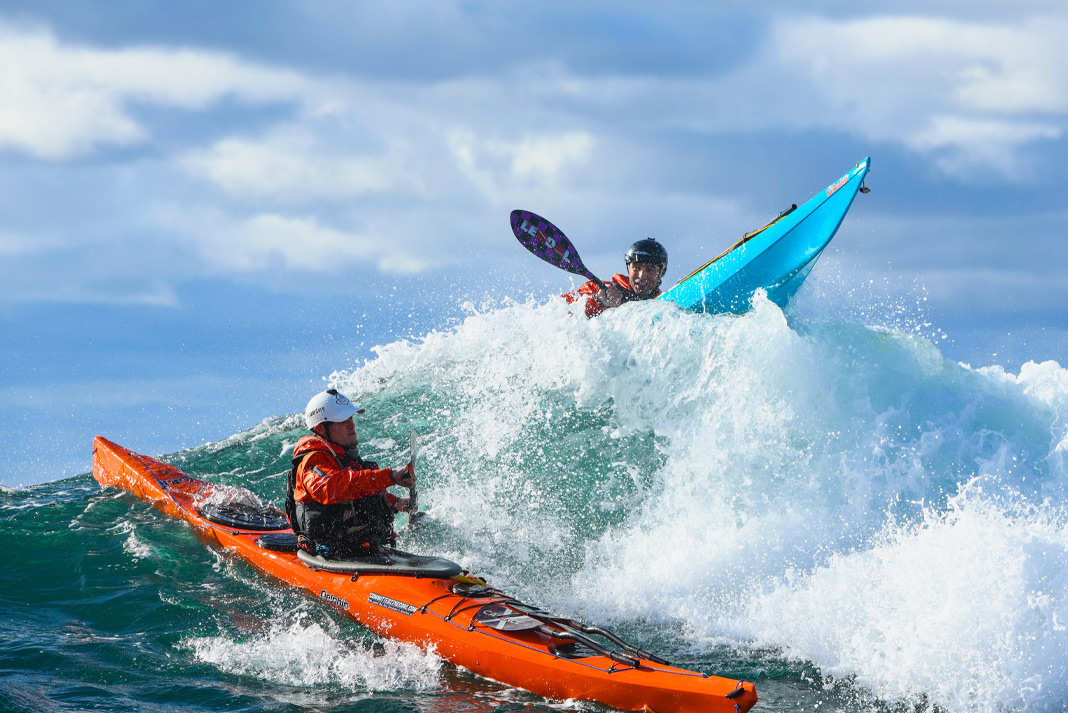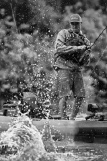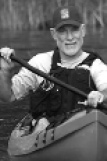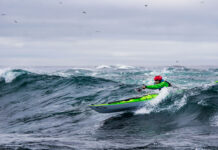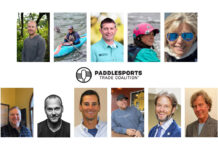What will the 2010s be remembered for?
The meteoric rise of SUP. MTI’s first booth at Surf Expo was in 2010. Most buyers had no idea life jackets were a United States Coast Guard regulation if you were paddling outside of the surf zone. Most buyers are now much better informed and educate customers about PFD use.
—Lili Colby, Co-founder, MTI Adventurewear
The gadgetization of paddling has skyrocketed. Time was, you needed a boat, life jacket and a paddle to get on the water. Now, you need the helmet, the drysuit, the GPS unit (so you know exactly where you are when you die), the neoprene gloves, the GoreTex socks, the waterproof phone cover and lanyard, the this and the that, in all the right shades and colors, made from the latest materials and manufactured by the groovy brand-de-jour. It’s like you can’t go paddling if you don’t have all the multi-colored shit.
—James Raffan, Explorer and Author
Disruption. Heraclitus once said, “The only constant in life is change,” and boy, was he right. There were more shifts in the past decade than the previous three. Kayak fishing went from a new sport to the fastest growing paddlesport and then to a new level of maturity and saturation we’ve never seen. Standup paddling went from prosperity to cessation faster than a shooting star. With the discontinuation of Royalex boats, canoeing went from an industry of sheer disquietude to a sport embraced by hipsters and retirees alike. Kayaking has experienced recession from longboats to short boats, putting strain on everyone from big conglomerate organizations to mom-and-pop shops looking to differentiate from Bass Pro and Walmart.
—Andrew Stern, Marketing Manager, Bending Branches
Stagnation, little innovation, and 80 percent of whitewater dealers closing their doors as companies—dealers and manufacturers—struggle to stay afloat as they sell into a market that demands that kayaks sell for less than it costs to make them.
—Corran Addison, Owner, Soul Waterman
What issue should all paddlers be paying attention to?
Paddler as consumer, driving the engines of commerce and environmental destruction. There seems to be a huge constituency—and the size of the group may be inflated by a skewed presence on social media—who are more interested in hedonistic river bagging and whitewater porn selfies than environmental philanthropy.
—James Raffan, Explorer and Author
In addition to ensuring access to quality education for all paddlers, we have to turn our attention to the 2020 elections and the state of our environment. Many individuals paddle to be in nature and get away from the hustle and bustle of their daily lives. As with every political cycle, the representatives we elect can have a profound impact on our ability to access pristine areas or limit and destroy our natural resources. We have to be an active participant and the voice of nature.
—Joshua Hall , Outdoor Program Manager, Charleston County Park and Recreation Commission
The “Amazon effect” is hurting specialty retailers, who are the core and heartbeat of the paddlesports industry. Many of our dealers are not hitting sales targets and are overstocked. With unstable weather conditions and more online shopping, many stores are struggling. Therefore, fewer paddlers are learning and engaging in paddlesports, creating uncertainty for everyone’s future.
—Andrew Stern, Marketing Manager, Bending Branches
What are you most excited about in paddlesports in 2020?
Paddlesports, particularly kayak angling, has reached an innovate-or-die stage. Kayak anglers are a passionate, tech-forward group. Anglers demand a product that makes fishing easier, so if you’re a paddlesports business that isn’t innovating within this space, you’re not growing. As the top fishing kayak brands compete and innovate, the consumer benefits. As a passionate angler myself, this excites me.
—Ryan Lilly, Brand & Product Manager, Johnson Outdoors Watercraft Division
Innovation and design exploration are still thriving. The new wave of creek boats with big bow rocker with playful edges and shapes make for fun sporty rides, and the reimagination of slice is a great trend. It’s always been a fun way to play the river, but now the hulls are better and they are way more comfortable.
—Shane Benedict, Co-Founder, Liquidlogic Kayaks
The way video producers portray wilderness canoeing. Folks like Chris Prouse, Northern Scavengers and the venerable Kevin Callan. For years I wondered how to attract more paddlers—particularly younger paddlers—and YouTube and other online video platforms are allowing our passion to reach a broader audience at their convenience.
—Simon Gardner, Co-founder, Adirondack Canoe Company
I am still excited about the sheer joy people have for being on the water. On the West Coast, we see a lot of retired paddlers out sea kayaking and living life to the fullest, and clubs seem to be thriving and are bringing folks together. We see these folks building their skills with ongoing courses and even coaching tours. We also find many people, living in smaller spaces and working and living downtown, are not buying gear but choose to rent.
—Brian Henry, Co-owner, Ocean River Sports
I’m excited about kayaking used for travel in combination with other multisport disciplines. Weight, size and packability of products are becoming ever more important as people take on multisport adventures. Making sure products keep pace with how athletes and adventurers of all calibers are trying to push boundaries is exciting as a designer.
—Mark “Snowy” Robertson, Designer
What is the biggest industry challenge in 2020?
Honestly, I think the industry’s biggest challenge isn’t cheap price point boats. I think our bigger challenge is adapting to consumer trends. As consumer groups shift to Gen X and Millennials, we’re seeing consumers with distinctly different expectations and motivations. If we can’t figure out how to meet the needs of the ever-evolving consumer, we’ll continue to be a challenged industry.
—Ryan Lilly, Brand & Product Manager, Johnson Outdoors Watercraft Division
It seems planned obsolescence has become a business model with many manufacturers.
—Tom Remsing, Co-Owner, Eddyline Kayaks
The average selling price has come way down on paddleboards over the past five years. This is a good thing, but buyer beware! There are good options at fair prices, but also plenty of crappy products attempting to reach the lowest price while sacrificing quality and performance.
—Jimmy Blakeney, Sales, Marketing & Digital Commerce Manager, BIC Sport
Import tariffs. This was a hot topic as it hit the industry in 2018 with very little warning. As an industry, everyone did well to step up to the challenge with short notice. Moving forward, the industry is still uneasy if import tariffs will increase, maintain, or even disappear.
—Shaun Allumbaugh, Whitewater Division Sale Manager, AIRE
Big box retailers are often where people buy their first boats because they’re cheap. Unfortunately, the chain stores often do not have staff who understand the boats and gear and cannot give good advice. It is so important for anyone paddling on the ocean or big bodies of water to have a safe boat built for the conditions, and for the paddler to get the training to be safe out there.
—Brian Henry, Co-Owner, Ocean River Sports
What tough issues are affecting paddlers?
The most controversial issue [in SUP] seems to be an accepted and efficient governing body. The fight between the International Canoe Federation and International Surf Association over who will take SUP to the Olympics frustrates the pro level while simultaneously alienating the enthusiast and feeder paddler streams.
—John Beausang, Publisher, Distressed Mullet
The best news for the industry is the demise of Sun Dolphin, the largest maker of kayak-shaped objects in the U.S. If you had a pulse and a storefront you could sell them, and most of the kayaking deaths in our region over the past few years were people who bought a kayak from a hardware store or gas station, took it out when the air was warm but the water was freezing, and capsized. Kayak-shaped objects do nothing to advance the sport but do a lot to hurt it. I may be putting a target on my back, but good riddance.
—Darren Bush, Owner, Rutabaga Paddlesports
Social media brings out some of the very worst in whitewater kayaking. Once the priority becomes posting rather than paddling, it brings artificial, low-quality content. People tend to show only what they think will make them look better or what will generate more likes. The audience often takes the images they see for absolute reality, but it is only a projection… I hate social media, but I also find it fascinating. And as a girl from France doing a niche, male, North American-dominated sport, it’s the most efficient way to get exposure and opportunities. It’s complex.
—Nouria Newman, Pro Whitewater Kayaker
Double blade paddling a canoe rather than single blade. Yes, I’ve used a double blade to help solo me across a big lake. It works, especially if you’re in a low-lying canoe design. But to use solely for an extended wilderness trip with a mix of rivers, streams, ponds and lakes makes little sense to me. I’ve joked double-bladed canoeists don’t know how to paddle. It’s meant in good fun—or is it?
—Kevin Callan, The Happy Camper
What does the future of paddling hold?
We are going into the “Age of Amazon” and the method of purchasing is online. This requires kayaks to be sent with UPS or FedEx, not big trucks… Kayaks shipped directly and quickly is the future of paddlesports.
—Tim Niemier, Owner, OnWater Designs
The explosion of cheap, down-market kayaks is disturbing. Many of these crafts do not address adequate safety and at the same time, teach new paddlers an unrealistic entry price. American manufacturers still face a significantly restricted market in the European Union due to tariffs. Additionally, the U.S. dollar is very strong against nearly all export markets. Taken together, our global sales have slowed.
—Bill Kueper, Vice-President, Wenonah Canoe and Current Designs Kayaks
There’s a good deal of uncertainty in the industry right now due to mergers and acquisitions, and I think that will be the driving story in paddlesports as the industry realigns and settles back into the new normal. At Pyranha, we are grateful not to be part of that story and we’ll be celebrating 50 years of business next year. Whitewater participation is in a really good position right now, which is exciting for us. Lots of young kids are getting in the sport, and tomorrow’s Dane Jackson is somewhere in that demographic.
—Chris Hipgrave, Pyranha Kayaks
As SUP matures, interesting trends are emerging. I never saw foil becoming a thing, especially given how it targets a very small subset of the sport. Nevertheless, foil keeps gaining popularity and becoming a regular feature in many lineups. I predict it will remain a small subset of SUP, but a growing one. On the race front, it’s also worth keeping an eye on the resurgence of the One Class series. SIC Maui and the WPA, together with other possible racing endorsing groups, are creating races with more accessible boards and formats, with the ability for brands to participate.
—Andre Niemeyer, SUP Connect
Canoe tripping is gaining popularity, especially with couples in their late twenties to early thirties, and especially with new immigrants. We’re not just a bunch of Bill Mason look-alikes anymore, with grey beards and stained Tilley hats. We’re a blend of young and old and multicultured.
—Kevin Callan, The Happy Camper
How do we translate recreational boaters into the enthusiasts? The sport needs people who see value in a $500 paddle. People aren’t going to stop paddling, because it’s fantastic, but how do you get people to buy into the lifestyle and gain more demand for premium products? It boils down to the people who you do it with—everyone likes kayaking, but getting people connected with family and friends or a club and on the water gets them hooked.
—Simon Coward, Owner, Aquabatics
What’s beyond the next wave might surprise you. Photo: Rob MacQuarrie



